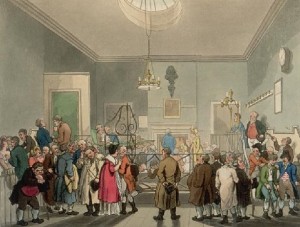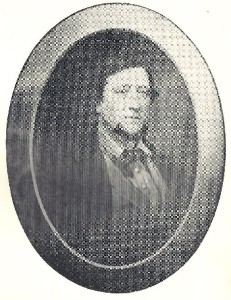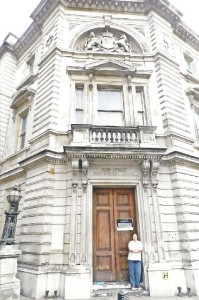I’m so excited to welcome today’s guest blogger to the Riskies! Sheri Cobb South is the author of the fabulous Regency-set John Pickett mysteries. One commenter will win a signed ARC of her newest title, Family Plot….
 In many ways, the history of London’s Bow Street force is too complex to be covered adequately in a blog. Whole books could be written—and have been—about this 18th century precursor to Scotland Yard. In his introduction to Henry Goddard’s Memoirs of a Bow Street Runner (William Morrow and Company, 1949), Patrick Pringle notes the lack of contemporary sources, almost all the official records having been destroyed in 1881, when the Bow Street Police Office moved from its original site adjacent to Covent Garden Theatre across the street to the site where the Bow Street Magistrate’s Court building may still be seen.
In many ways, the history of London’s Bow Street force is too complex to be covered adequately in a blog. Whole books could be written—and have been—about this 18th century precursor to Scotland Yard. In his introduction to Henry Goddard’s Memoirs of a Bow Street Runner (William Morrow and Company, 1949), Patrick Pringle notes the lack of contemporary sources, almost all the official records having been destroyed in 1881, when the Bow Street Police Office moved from its original site adjacent to Covent Garden Theatre across the street to the site where the Bow Street Magistrate’s Court building may still be seen.
 Still, certain factoids concerning the Bow Street force—their red waistcoats, for instance—turn up again and again in novels, assumed by authors to be accurate by their very ubiquitousness; this was certainly my own view when I set out to create Bow Street Runner John Pickett and his world for my mystery series. But when I discovered the aforementioned Memoirs, published by Goddard’s grandson’s widow from his notebooks, I realized that many of the things I thought I knew about Bow Street were wrong.
Still, certain factoids concerning the Bow Street force—their red waistcoats, for instance—turn up again and again in novels, assumed by authors to be accurate by their very ubiquitousness; this was certainly my own view when I set out to create Bow Street Runner John Pickett and his world for my mystery series. But when I discovered the aforementioned Memoirs, published by Goddard’s grandson’s widow from his notebooks, I realized that many of the things I thought I knew about Bow Street were wrong.
Take those red waistcoats, for instance. They are accurate to a point; the Horse Patrol wore them, as did, later, the foot patrol. But the Runners were always a plainclothes force, and very deliberately so: the independent English mind had a horror of the kind of martial law found in European countries, and Bow Street founder Henry Fielding (he of Tom Jones fame) had the wisdom to know that anything resembling a uniform was to be avoided. Even when the Horse Patrol costume was standardized half a century later, in 1805, every care was taken to be sure that their blue coats and red waistcoats looked as much like civilian dress as possible.
Nor was everyone on the Bow Street force created equal—and not everyone was a Runner. The members of the Foot Patrol worked at night, and earned the lowest wages at half a crown—two and a half shillings—a day. As one might expect, this bottom rung of the ladder was where many eventual Runners started out, including memoirist Henry Goddard. He enlisted in the Foot Patrol in 1824, five years before Robert Peel’s Metropolitan Police would begin to encroach upon the Runners’ territory. Within a year or two Goddard was promoted to the Day Patrol at a salary of three shillings and sixpence per day. Finally he rose to the position of principal officer—those individuals we know as Runners. (He was twenty-six years old at the time, which told me I was not too far afield in letting my precocious young John Pickett achieve that position at age twenty-three.)
Bow Street Runners were paid twenty-five shillings a week, but they had other ways of supplementing their income. The first of these was by private commission on behalf of anyone who was able to pay them. The fee for their services was usually a guinea a day and, if the case should take them beyond London, fourteen shillings a day for travel expenses, including meals and lodging. If the case was successful, a reward would be paid as well.
Another, more controversial, income stream derived from the longstanding practice of offering payment for convictions. As one might imagine, such a system invited corruption, which had reached its peak (or perhaps its nadir) with the 18th century “Thief-Taker General” Jonathan Wild, who enticed the young and/or gullible into committing crimes so that he might collect rewards for bringing them to justice. Although Wild was hanged for his crimes almost a quarter-century before Fielding’s establishment of the Bow Street Runners, his memory still lived in the public consciousness, and even in death he managed to blacken the reputation of a Bow Street force which operated under a very similar system.
 While the creation of the Metropolitan Police in 1829 marked a change in law enforcement in what was the most populous city in the world at the time, it did not mean the immediate end of the Bow Street Runners. They continued in their role of detectives, and their civilian dress gave them advantages over the uniformed—and consequently more conspicuous—New Police. It was not until 1839, ninety years after their founding, that the Bow Street Runners ceased to exist. Even so, Henry Goddard continued to operate as a private detective as late as 1856, and very likely longer.
While the creation of the Metropolitan Police in 1829 marked a change in law enforcement in what was the most populous city in the world at the time, it did not mean the immediate end of the Bow Street Runners. They continued in their role of detectives, and their civilian dress gave them advantages over the uniformed—and consequently more conspicuous—New Police. It was not until 1839, ninety years after their founding, that the Bow Street Runners ceased to exist. Even so, Henry Goddard continued to operate as a private detective as late as 1856, and very likely longer.
In addition to giving us an insiders’ look at the sort of cases a Bow Street Runner might be called upon to investigate, Goddard’s Memoirs offer a glimpse of the birth of modern forensics. In one of his cases, for example, he recalls his discovery that the balls fired from a particular gun left holes of a distinctive shape—a circumstance that allowed him to identify the exact weapon used.
Memoirs of a Bow Street Runner is out of print today, but might still be found through interlibrary loan or used-book sites such as www.bookfinder.com.

Thank you; I didn’t know that there were different grades of Bow Street staff, and that only the top grade could called “Runners”. It’s also interesting that former Runners continued to work as private detective so long after the force was abolished.
I’d seen a few vague references to Foot Patrol and Horse Patrol, but I didn’t realize they were as structured as they were. I read somewhere that there were six principal officers (aka Runners) at any given time, but since I couldn’t recall where I’d seen it and therefore couldn’t cite my source, I didn’t include it here.
As for them working as private detectives, we know that Henry Goddard did, and I wouldn’t be surprised if others did, as well.
Thanks so much for this post – it clarifies many things I have wondered about for years.
Thank YOU! I’m glad to have been of help.
I love it when the Bow Street Runners are a big part of a story. They add a different perspective on Regency Life.
They certainly do! Quite a contrast from the “ton” we usually read about. It was especially fun for me to contrast John Pickett’s world with that of the widowed Lady Fieldhurst, especially as their mutual attraction becomes harder and harder to deny.
Thanks so much for this fantastic guest post, Sherri!
Thank you (and all the other Riskies) for giving me the opportunity! I’m glad you enjoyed it.
Congratulations, Sandra! You won the ARC of Family Plot. If you’ll send me an email with your address, I’ll get it in the mail to you. I hope you enjoy it!
I’m a bit late to the party, but just wanted to say how much I enjoyed your post, Sheri, and how nice it was to have you visit! Fun to have some insight into how you created your John Pickett!!
Thanks, Gail! I appreciate having the opportunity.